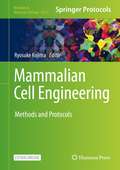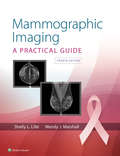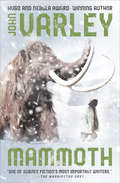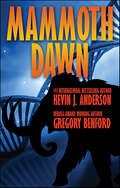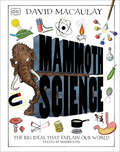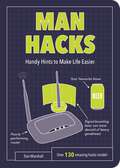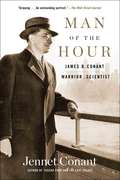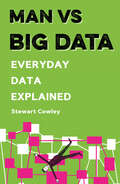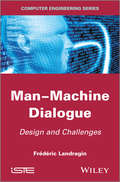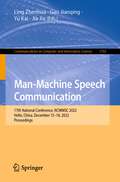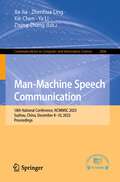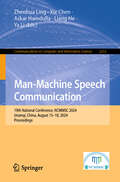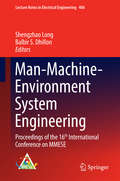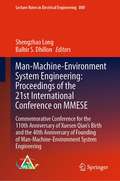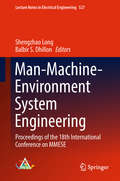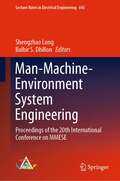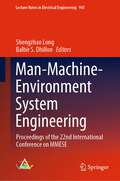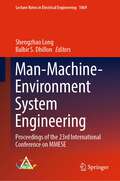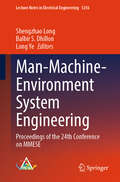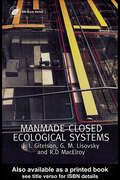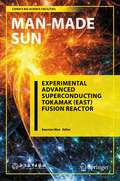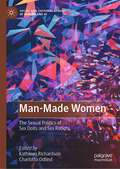- Table View
- List View
Mammalian Cell Engineering: Methods and Protocols (Methods in Molecular Biology #2312)
by Ryosuke KojimaThis volume explores the latest engineering methods of mammalian cells that are useful for controlling the performance of engineered mammalian cells for future cell-based therapeutics and for better understanding of complex biological systems. The chapters in this book are organized into five parts. Part One described methods to engineer mammalian cells to sense biologically relevant inputs, such as cell contacts and soluble proteins. Part Two looks at techniques to engineer mammalian cells to sense artificial inputs, such as light and ultrasound. Part Three provides cutting-edge CRISPR-Cas-based methods to carry out highly multiplexed genome editing and spatiotemporally controlled genome editing. Part Four discusses ways to control and engineer biological events in mammalian cells in combination with chemical compounds and systems. Part Five explores techniques to engineer specific mammalian cells in targeted manners. Written in the highly successful Methods in Molecular Biology series format, chapters include introductions to their respective topics, lists of the necessary materials and reagents, step-by-step, readily reproducible laboratory protocols, and tips on troubleshooting and avoiding known pitfalls.Comprehensive and authoritative, Mammalian Cell Engineering: Methods and Protocols is a valuable resource that allows scientists to successfully carry out their research, thus ultimately contributing to the future advancement of this field.
Mammographic Imaging: A Practical Guide
by Shelly Lille Wendy MarshallPublisher's Note: Products purchased from 3rd Party sellers are not guaranteed by the Publisher for quality, authenticity, or access to any online entitlements included with the product. The 4th Edition of Mammographic Imaging: A Practical Guide remains the most up-to-date and comprehensive book in the field. A perfect all-in-one solution for coursework, board prep, and clinical practice, this bestseller reflects the latest ARRT educational and certification exam requirements, as well as the ASRT recommended curriculum. Technologists seeking to stay current in the profession and students preparing to enter the field will appreciate the 227 new photos, the wide range of case studies, and the interactive online exam simulator with ARRT registry-style questions.
Mammoth
by John VarleyA &“rollicking, bittersweet tale of time travel and ecology&” from the Nebula and Hugo Award–winning author of the Gaea Trilogy (Publishers Weekly, starred review). &“H. G. Wells meets Jurassic Park&” in this novel about a multibillionaire, a time machine, and a baby woolly mammoth named Little Fuzzy (The Best Reviews). The discovery of a perfectly preserved frozen mammoth in the Canadian wilderness gives wealthy visionary Howard Christian the opportunity of a lifetime: to clone it. But what really piques Christian&’s curiosity is what he finds next to the mammoth: a metal box—and the mummified body of a man wearing a watch. Working to discover the box&’s purpose and clone the mammoth, a top physicist and an elephant veterinarian will be flung thousands of years into the past and back again—bringing a baby mammoth along for the ride—in this &“imaginative and engaging&” adventure that shows &“Varley . . . in top form&” (San Francisco Chronicle). Praise for John Varley &“John Varley is the best writer in America.&” —Tom Clancy &“There are few writers whose work I love more than John Varley&’s, purely love.&” —Cory Doctorow &“One of science fiction&’s most important writers.&” —The Washington Post &“Inventive.&” —The New York Times &“One of the genre&’s most accomplished storytellers.&” —Publishers Weekly
Mammoth Dawn
by Gregory Benford Kevin J. AndersonExtinction is not permanent. Not anymore. Multi-millionaire researcher Alex Pierce has developed cutting-edge genetic techniques to extract viable DNA from preserved samples of breathtaking species that humans have erased from the Earth. From passenger pigeons and Tasmanian tigers, to Pleistocene dire wolves and sabretooths…even the humble dodo. The cornerstone of Alex’s dream is to resurrect the woolly mammoth. Majestic and massive, these creatures no longer roam the world, driven to extinction by ancient hunters. At his isolated Pleistocene Ranch in the wilds of Montana, Alex has actually bred the very first mammoth to walk the Earth in 10,000 years. But there are those who believe what is extinct should remain extinct, and that any tampering goes against the laws of nature. And their fervor may be far stronger than Alex’s dreams. Mammoth Dawn is the original acclaimed novella written by New York Times bestseller and Hugo and Nebula Award nominee Kevin J. Anderson and multiple Hugo and Nebula winner Gregory Benford; this volume also includes their detailed chapter-by-chapter treatment of the full novel the two authors originally envisioned, as well as a non-fiction overview of current scientific attempts to clone mammoths—a reality that may be much closer than you think.
Mammoth Science: The Big Ideas That Explain Our World (DK David Macaulay How Things Work)
by DKDavid Macaulay's troupe of curious mammoths lead you through the basics of physics, biology, and chemistry in this unconventional and highly original guide to science.From the interior of an atom to the solar system and beyond, the mammoths seek to understand the science! These intrepid science demonstrators will go to incredible lengths to educate and entertain. They wrestle with magnets to understand their powerful force, make mammoth models of different materials explore what gives them mass, and step into an X-ray machine to reveal the bones beneath their woolly exterior.Observing and recording the mammoth's behavior is bestselling illustrator David Macaulay, whose How Machines Work won the Royal Society Young People's Book Prize in 2016. Renowned for his ability to explain complex ideas with simple genius, Macaulay captures the oddball humor of his subject matter, making Macaulay's Mammoth Science the perfect introduction to scientific principles for the young and the young-at-heart.
Man Hacks: Handy Hints to Make Life Easier (Life Hacks Ser.)
by Dan MarshallMAN HACKS is the ultimate guide to making essential guy stuff easier. This fully illustrated manual covers everything from culinary cheats, DIY secrets and tidying-up shortcuts to style tips and party tricks – everything you need to keep your man credentials fully in check.
Man of the Hour: James B. Conant, Warrior Scientist
by Jennet ConantThe remarkable life of one of the most influential men of the greatest generation, James B. Conant—a savvy architect of the nuclear age and the Cold War—told by his granddaughter, New York Times bestselling author Jennet Conant.James Bryant Conant was a towering figure. He was at the center of the mammoth threats and challenges of the twentieth century. As a young eminent chemist, he supervised the production of poison gas in WWI. As a controversial president of Harvard University, he was a champion of meritocracy and open admissions. As an advisor to FDR, he led the interventionist cause for US entrance in WWII. During that war, Conant was the administrative director of the Manhattan Project, oversaw the development of the atomic bomb and argued that it be used against the industrial city of Hiroshima in Japan. Later, he urged the Atomic Energy Commission to reject the hydrogen bomb, and devoted the rest of his life to campaigning for international control of atomic weapons. As Eisenhower’s high commissioner to Germany, he helped to plan German recovery and was an architect of the United States’ Cold War policy. Now New York Times bestselling author Jennet Conant recreates the cataclysmic events of the twentieth century as her grandfather James experienced them. She describes the guilt, fears, and sometimes regret of those who invented and deployed the bombs and the personal toll it took. From the White House to Los Alamos to Harvard University, Man of the Hour is based on hundreds of documents and diaries, interviews with Manhattan Projects scientists, Harvard colleagues, and Conant’s friends and family, including her father, James B. Conant’s son. This is a very intimate, up-close look at some of the most argued cases of modern times—among them the use of chemical weapons, the decision to drop the bomb, Oppenheimer’s fate, the politics of post-war Germany and the Cold War—the repercussions of which are still affecting our world today.
Man vs Big Data: Everyday Data Explained
by Stewart CowleyHave you ever wondered how to beat the bookies? How does your computer know you might like this song? Should you be worried about this?... We can&’t answer that for you, but Man vs Big Data does explore the numerous ways in which &‘Big Data&’ has, sometimes imperceptibly, infiltrated our lives. Everything we do leaves a trail of data behind, from buying something on a credit card, to using a GPS-enabled mobile phone – whether you know it or not, like it or not, Big Data is now a part of modern life. Heralded as the Fourth Industrial Revolution, it is now more crucial than ever to learn about how data is affecting the way we live. Man vs Big Data proves that this topic is one of the most important subjects facing us today and helps you get to grips with what that means for you.
Man-Machine Dialogue: Design and Challenges
by Frederic LandraginThis book summarizes the main problems posed by the design of a man–machine dialogue system and offers ideas on how to continue along the path towards efficient, realistic and fluid communication between humans and machines. A culmination of ten years of research, it is based on the author’s development, investigation and experimentation covering a multitude of fields, including artificial intelligence, automated language processing, man–machine interfaces and notably multimodal or multimedia interfaces. Contents Part 1. Historical and Methodological Landmarks 1. An Assessment of the Evolution of Research and Systems. 2. Man–Machine Dialogue Fields. 3. The Development Stages of a Dialogue System. 4. Reusable System Architectures. Part 2. Inputs Processing 5. Semantic Analyses and Representations. 6. Reference Resolution. 7. Dialogue Acts Recognition. Part 3. System Behavior and Evaluation 8. A Few Dialogue Strategies. 9. Multimodal Output Management. 10. Multimodal Dialogue System Assessment. About the Authors Frédéric Landragin is a computer science engineer and has a PhD from the University of Lorraine, France. He is currently in charge of linguistics research for the French National Center for Scientific Research (CNRS). His studies focus on the analysis and modeling of language interpretation. Man–machine dialogue is one of the applications of this research.
Man-Machine Speech Communication: 17th National Conference, NCMMSC 2022, Hefei, China, December 15–18, 2022, Proceedings (Communications in Computer and Information Science #1765)
by Ling Zhenhua Gao Jianqing Yu Kai Jia JiaThis book constitutes the refereed proceedings of the 17th National Conference on Man–Machine Speech Communication, NCMMSC 2022, held in China, in December 2022.The 21 full papers and 7 short papers included in this book were carefully reviewed and selected from 108 submissions. They were organized in topical sections as follows: MCPN: A Multiple Cross-Perception Network for Real-Time Emotion Recognition in Conversation.- Baby Cry Recognition Based on Acoustic Segment Model, MnTTS2 An Open-Source Multi-Speaker Mongolian Text-to-Speech Synthesis Dataset.
Man-Machine Speech Communication: 18th National Conference, NCMMSC 2023, Suzhou, China, December 8–10, 2023, Proceedings (Communications in Computer and Information Science #2006)
by Ya Li Xie Chen Jia Jia Zhenhua Ling Zixing ZhangThis book constitutes the refereed proceedings of the 18th National Conference on Man-Machine Speech Communication, NCMMSC 2023, held in Suzhou, China, during December 8–11, 2023.The 20 full papers and 11 short papers included in this book were carefully reviewed and selected from 117 submissions. They deal with topics such as speech recognition, synthesis, enhancement and coding, audio/music/singing synthesis, avatar, speaker recognition and verification, human–computer dialogue systems, large language models as well as phonetic and linguistic topics such as speech prosody analysis, pathological speech analysis, experimental phonetics, acoustic scene classification.
Man-Machine Speech Communication: 19th National Conference, NCMMSC 2024, Urumqi, China, August 15–18, 2024, Proceedings (Communications in Computer and Information Science #2312)
by Ya Li Xie Chen Zhenhua Ling Askar Hamdulla Liang HeThis book constitutes the refereed proceedings of the 19th National Conference on Man-Machine Speech Communication, NCMMSC 2024, held in Urumqi, China, during August 15–18, 2024. The 33 papers included in these proceedings were carefully reviewed and selected from 205 submissions. They deal with topics such as speech technology and large language models, audio processing, prosody modeling and dialogue systems. Key areas include speech recognition, speaker identification and verification, speech/sound/music synthesis, speech enhancement, sound event detection, multimodal systems, conversational AI, phonetics, phonology and prosody analysis, auditory processing, and acoustic scene modeling etc.
Man-Machine-Environment System Engineering
by Balbir S. Dhillon Shengzhao LongThe integrated and advanced science research topic Man-Machine-Environment system engineering (MMESE) was first established in China by Professor Shengzhao Long in 1981, with direct support from one of the greatest modern Chinese scientists, Xuesen Qian. In a letter to Shengzhao Long from October 22nd, 1993, Xuesen Qian wrote: "You have created a very important modern science and technology in China!" MMESE primarily focuses on the relationship between man, machines and the environment, studying the optimum combination of man-machine-environment systems. In this system, "man" refers to people in the workplace (e. g. operators, decision-makers); " machine" is the general name for any object controlled by man (including tools, machinery, computers, systems and technologies), and "environment" describes the specific working conditions under which man and machine interact (e. g. temperature, noise, vibration, hazardous gases etc. ). The three goals of optimization of Man-Machine-Environment systems are to ensure safety, efficiency and economy. Proceedings of the 13th International Conference on Man-Machine-Environment System Engineering are an academic showcase of the best papers selected from more than 400 submissions, introducing readers to the top research topics and the latest developmental trends in the theory and application of MMESE. These proceedings are interdisciplinary studies on the concepts and methods of physiology, psychology, system engineering, computer science, environment science, management, education, and other related disciplines. Researchers and professionals working in these interdisciplinary fields and researchers on MMESE related topics will benefit from these proceedings.
Man-Machine-Environment System Engineering: Commemorative Conference for the 110th Anniversary of Xuesen Qian’s Birth and the 40th Anniversary of Founding of Man-Machine-Environment System Engineering (Lecture Notes in Electrical Engineering #800)
by Balbir S. Dhillon Shengzhao LongMan-Machine-Environment System Engineering: Proceedings of the 21st Conference on MMESE is the academic showcase of best research papers selected from more than 500 submissions each year. From this book reader will learn the best research topics and the latest development trend in MMESE design theory and other human-centered system application.MMESE focus mainly on the relationship between Man, Machine and Environment. It studies the optimum combination of man-machine-environment systems. In the system, the Man means the working people as the subject in the workplace (e.g. operator, decision-maker); the Machine means the general name of any object controlled by the Man (including tool, Machinery, Computer, system and technology), the Environment means the specially working conditions under which Man and Machine occupy together(e.g. temperature, noise, vibration, hazardous gases etc.). The three goals of the optimization of the system are safety, efficiency and economy.In 1981 with direct support from one of the greatest modern Chinese scientists, Qian Xuesen, Man-Machine-Environment System Engineering (MMESE), the integrated and advanced science research topic was established in China by Professor Shengzhao Long. In the letter to Shengzhao Long, in October 22nd, 1993, Qian Xuesen wrote: “You have created a very important modern science subject and technology in China!”.
Man-Machine-Environment System Engineering: Proceedings Of The 16th International Conference On Mmese (Lecture Notes In Electrical Engineering #406)
by Balbir S. Dhillon Shengzhao LongThese proceedings showcase the best papers selected from more than 500 submissions, and introduce readers to the hottest research topics and the latest developmental trends in the theory and application of MMESE. The integrated and advanced science research topic Man-Machine-Environment System Engineering (MMESE) was first established in China by Professor Shengzhao Long in 1981, with direct support from one of the greatest modern Chinese scientists, Xuesen Qian. In a letter to Long from October 22nd, 1993, Qian wrote: “You have created a very important modern science and technology in China!” MMESE primarily focuses on the relationship between Man, Machine and Environment, studying the optimum combination of man-machine-environment systems. In this system, “Man” refers to working people as the subject in the workplace (e.g. operators, decision-makers); “Machine” is the general name for any object controlled by Man (including tools, machinery, computers, systems and technologies), and “Environment” describes the specific working conditions under which Man and Machine interact (e.g. temperature, noise, vibration, hazardous gases etc.). The three main goals of optimizing man-machine-environment systems are to ensure safety, efficiency and economy. These proceedings present interdisciplinary studies on essential concepts and methods from physiology, psychology, system engineering, computer science, environmental science, management, education, and other related disciplines. As such, they offer a valuable resource for all researchers and professionals whose work involves interdisciplinary areas touching on MMESE subjects.
Man-Machine-Environment System Engineering: Proceedings of the 20th International Conference on MMESE (Lecture Notes in Electrical Engineering #645)
by Balbir S. Dhillon Shengzhao LongThis book presents selected papers introducing readers to the key research topics and latest development trends in the theory and application of MMESE. The advanced integrated research topic man-machine-environment system engineering (MMESE) was first established in China by Professor Shengzhao Long in 1981, with direct support from one of the greatest modern Chinese scientists, Xuesen Qian. In a letter to Shengzhao Long from October 22nd, 1993, Xuesen Qian wrote: “You have created a very important modern science and technology in China!”MMESE primarily focuses on the relationship between man, machine and environment, studying the optimum combination of man-machine-environment systems, where “man” refers to people in the workplace (e.g., operators, decision-makers), “machine” is the general name for any object controlled by man (including tools, machinery, computers, systems and technologies), and “environment” describes the specific working conditions under which man and machine interact (e.g., temperature, noise, vibration and hazardous gases). The three goals of optimizing such systems are ensuring safety, efficiency and economy.Presenting interdisciplinary studies on the concepts and methods in physiology, psychology, system engineering, computer science, environmental science, management, education and other related disciplines, this book is a valuable resource for all researchers and professionals whose work involves MMESE subjects.
Man-Machine-Environment System Engineering: Proceedings of the 22nd International Conference on MMESE (Lecture Notes in Electrical Engineering #941)
by Balbir S. Dhillon Shengzhao LongMan-Machine-Environment System Engineering: Proceedings of the 22nd Conference on MMESE are an academic showcase of the best papers selected from more than 500 submissions, introducing readers to the top research topics and the latest developmental trends in the theory and application of MMESE. This proceedings are interdisciplinary studies on the concepts and methods of physiology, psychology, system engineering, computer science, environment science, management, education, and other related disciplines. Researchers and professionals who study an interdisciplinary subject crossing above disciplines or researchers on MMESE subject will be mainly benefited from this proceedingsMMESE primarily focuses on the relationship between Man, Machine and Environment, studying the optimum combination of man-machine-environment systems. In this system, “Man” refers to working people as the subject in the workplace (e.g. operators, decision-makers); “Machine” is the general name for any object controlled by Man (including tools, machinery, computers, systems and technologies), and “Environment” describes the specific working conditions under which Man and Machine interact (e.g. temperature, noise, vibration, hazardous gases etc.). The three goals of optimization of the man-machine-environment systems are to ensure safety, efficiency and economy. The integrated and advanced science research topic Man-Machine-Environment System Engineering (MMESE) was first established in China by Professor Shengzhao Long in 1981, with direct support from one of the greatest modern Chinese scientists, Xuesen Qian. In a letter to Shengzhao Long from October 22nd, 1993, Xuesen Qian wrote: “You have created a very important modern science and technology in China!”
Man-Machine-Environment System Engineering: Proceedings of the 23rd International Conference on MMESE (Lecture Notes in Electrical Engineering #1069)
by Balbir S. Dhillon Shengzhao LongMan-Machine-Environment System Engineering: Proceedings of the 23rd Conference on MMESE are an academic showcase of the best papers selected from more than 500 submissions, introducing readers to the top research topics and the latest developmental trends in the theory and application of MMESE. This proceedings are interdisciplinary studies on the concepts and methods of physiology, psychology, system engineering, computer science, environment science, management, education, and other related disciplines. Researchers and professionals who study an interdisciplinary subject crossing above disciplines or researchers on MMESE subject will be mainly benefited from this proceedings.MMESE primarily focuses on the relationship between Man, Machine and Environment, studying the optimum combination of man-machine-environment systems. In this system, “Man” refers to working people as the subject in the workplace (e.g. operators, decision-makers); “Machine” is the general name for any object controlled by Man (including tools, machinery, computers, systems and technologies), and “Environment” describes the specific working conditions under which Man and Machine interact (e.g. temperature, noise, vibration, hazardous gases etc.). The three goals of optimization of the man-machine-environment systems are to ensure safety, efficiency and economy.The integrated and advanced science research topic Man-Machine-Environment System Engineering (MMESE) was first established in China by Professor Shengzhao Long in 1981, with direct support from one of the greatest modern Chinese scientists, Xuesen Qian. In a letter to Shengzhao Long from October 22nd, 1993, Xuesen Qian wrote: “You have created a very important modern science and technology in China!”
Man-Machine-Environment System Engineering: Proceedings of the 24th Conference on MMESE (Lecture Notes in Electrical Engineering #1256)
by Balbir S. Dhillon Shengzhao Long Long YeFrom this book reader will learn the best research topics and the latest development trend in MMESE theory and application. Man-Machine-Environment System Engineering (MMESE) is a scientific study on the design concepts and quantitative analysis of a complex giant system using physiology, psychology, system engineering, computer science, environment science, management theory, education, and other related disciplines methods. MMESE focuses mainly on the relationship and the optimum combination between Man, Machine, and Environment. The three optimized goals of the MMESE study are safety, efficiency, and economy. Researchers and professionals who study a human-centered interdisciplinary subject crossing above disciplines will be mostly benefited from this proceedings. In 1981 with direct support from one of the greatest modern Chinese scientists, Xuesen Qian, Man-Machine-Environment System Engineering (MMESE), the integrated and advanced science research topic was established in China by Professor Shengzhao Long. Man-Machine-Environment System Engineering: Proceedings of the 24th Conference on MMESE is the academic showcase of latest research papers selected from more than 500 submission in this field in 2024.
Man-Made Closed Ecological Systems
by J.I. Gitelson G.M. LisovskyProviding a broad historical perspective, this book explores the interactions between humans, microorganisms, and plants in a closed habitat, and the life support systems necessary to maintain habitability over long periods of time. Topics include the cultivation of bacteria, microalgae and higher plants; the use of biotechnology to support life outside the Earth's biosphere; methods for recycling air, water and food for human consumption; interactions between humans and other organisms in CMESs; and methods for intensifying the level of photosynthesis. In addition to space the authors investigate problems associated with living conditions in dangerous or difficult environmental areas on Earth such as the Arctic and Antarctica, deserts and mountains.
Man-Made Sun: Experimental Advanced Superconducting Tokamak (EAST) Fusion Reactor (China’s Big Science Facilities)
by Baonian WanThis book introduces the research process and principles of the controlled super-coupling nuclear fusion experiment at the Experimental Advanced Superconducting Tokamak (EAST) nuclear fusion reactor in Hefei, China. It uses straightforward language to explain how nuclear fusion can provide safe, environmentally friendly, clean, and inexhaustible energy in future. EAST is the world’s first fully superconducting, non-circular cross-section tokamak nuclear fusion experimental device, independently developed by the Chinese Academy of Sciences. This book helps demonstrate China’s cutting-edge scientific and technological advances to the rest of the world, helps spread the scientific spirit to people around the globe, and promotes prosperity and development. The book is intended for all non-experts who would like to learn more about nuclear energy and related technologies.
Man-Made Women: The Sexual Politics of Sex Dolls and Sex Robots (Social and Cultural Studies of Robots and AI)
by Kathleen Richardson Charlotta OdlindThis book presents a unique, feminist approach to ‘sex’ dolls and ‘sex’ robots, taking a critical look at the academic and business narratives that serve to rationalise them. As new forms of pornography (porn robots), this edited volume provides an urgent women’s centred critique. The emergence of ‘sex’ robots is situated within the wider context of the attack on women’s rights and the relentless rise of techno-pornography. As an outgrowth of the industries of prostitution, pornography and child sex abuse, these objects offer new ways to dehumanise women and girls. While support for ‘sex’ robots is positioned as progressive and emancipatory, the contributors in this volume argue they reduce women to consumable parts. They explore how law, the arts, ethics, economy, politics and culture are interconnected with harmful technological developments.
Man-Made Wonders of the World (DK Wonders of the World)
by DKDiscover the most incredible man-made wonders, from Stonehenge to Burj Khalifa, with this unparalleled catalog of the most famous and intriguing buildings and monuments created by humans.Man-Made Wonders of the World features a range of structures from buildings to monuments, statues, and bridges, including the Golden Gate Bridge and Hoover Dam. It opens with a foreword by Dan Cruickshank and then takes the reader on a continent-by-continent journey, exploring and charting the innovations, ingenuity, and imagination employed by different cultures to create iconic buildings such as the Great Pyramid of Giza. This truly global approach reveals how humans tackled similar challenges, such as keeping the enemy out, in vastly different parts of the world, from the Great Wall of China to the defensive walls of Central American cities. Illustrations explain how the structures were built, while explanations cover the history, architecture, and unique stories behind their construction. Featuring breathtaking images, Man-Made Wonders of the World is a complete celebration of the world humans have built over thousands of years.
Man-Made: How the bias of the past is being built into the future
by Tracey SpicerWalkley Award-winning journalist Tracey Spicer exposes the next frontier of feminism. Man-Made aims to open readers&’ eyes to a transformative technological shift in society and give them the tools to make positive change. `Mum, I want a robot slave.&’ Broadcaster Tracey Spicer had an epiphany when her young son uttered these six words. Suddenly, her life&’s work fighting inequality seemed futile. What&’s the point in agitating to change the present, if bigotry is being embedded into our futures? And so began a quest to uncover who was responsible and hold them to account. Who is the ultimate villain? Big Tech, whose titans refuse to spend money to fix the problem? The world&’s politicians, who lack the will to legislate? Or should we all be walking into a hall of mirrors and taking a good, hard look at ourselves…? This is a deeply researched, illuminating and gripping ride into an uncertain future, culminating in a resounding call to action that will shake the tech sector to its foundations.Praise for Man-Made &‘Exhilarating … The book we need as we grapple with how AI will change our lives and our world.&’ Dame Quentin Bryce &‘Brilliant, hilarious and terrifying. You&’ll never see Alexa the same way again.&’ Juanita Phillips &‘Tracey Spicer uses her unmistakably human voice to warn us all about the deeply sexist Frankenstein&’s Monster that is modern AI.&’ Yumi Stynes
Manage Your Own Learning Analytics: Implement a Rasch Modelling Approach (Smart Innovation, Systems and Technologies #261)
by Elspeth McKayThis book sheds light on the practice of learning analytics, illuminating how others approach their data analysis. At the beginning of the book, a ‘prescriptive learning analytics planning model’ gives straightforward instructions for people to follow. This book is organized into ten chapters, falling into four topical sections: Managing Learning Analytics (overview, instructional systems design (ISD), instructional design, and planning data analysis); Cognitive Performance Measurement Practices (classical test theory (CTT), Rasch measurement theory (RMT), Item response theory(IRT), Rasch Modeling Tools (research design, setting methodology); and Case Studies (corporate training settings, healthcare industry, and educational courseware design). This book is an important reference for: educational research community and instructional systems designers; corporate training developers; postgraduate course developers; and doctoral students.
